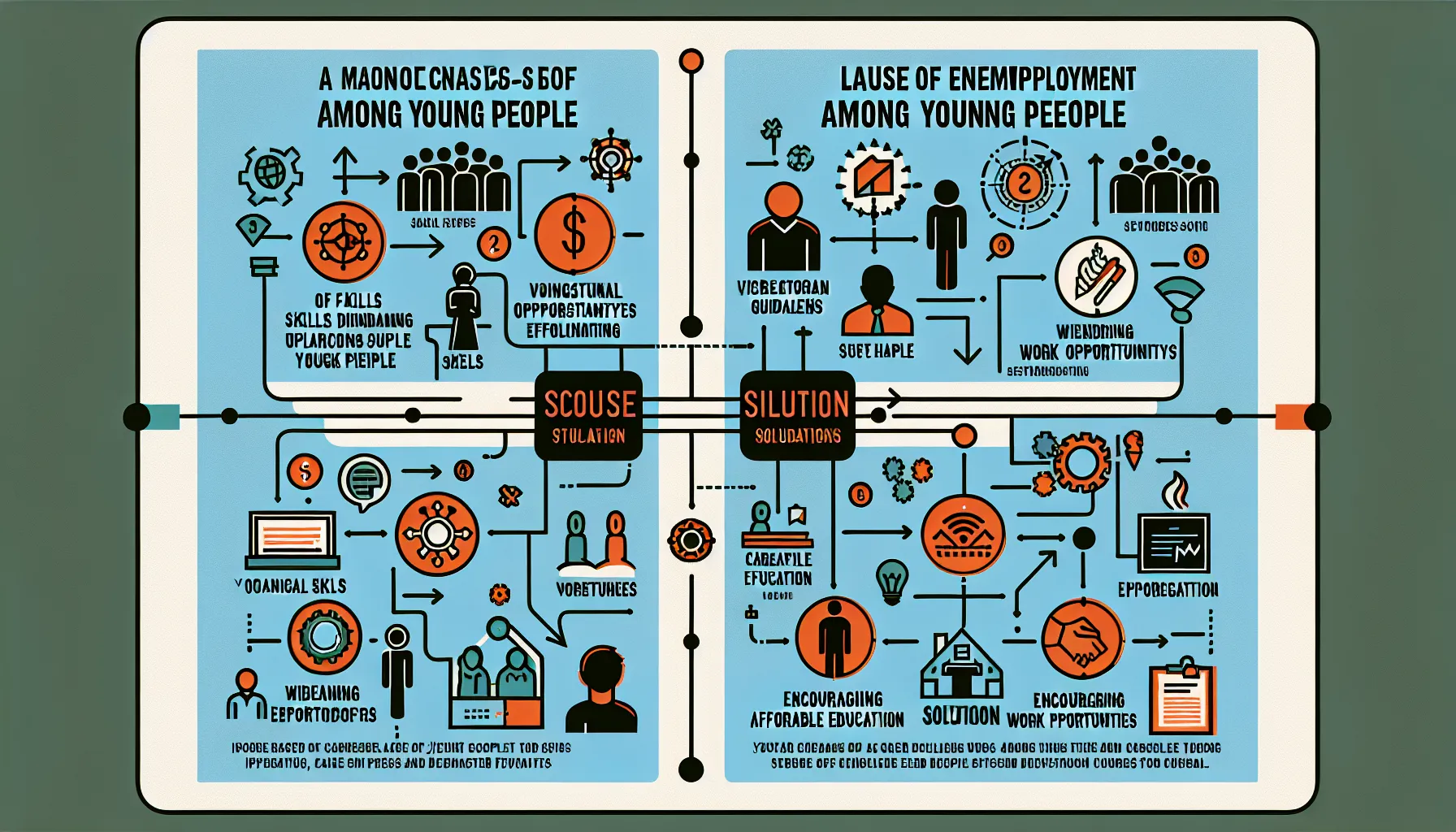Youth unemployment is a pressing global issue that frequently appears in IELTS Writing Task 2 questions. Based on recent trends and the importance of this topic, it’s highly likely that you may encounter a question related to addressing youth unemployment in your IELTS exam. Let’s explore this topic through sample essays and in-depth analysis to help you prepare effectively.
Analyzing the Task 2 Question
Let’s consider the following IELTS Writing Task 2 question:
Many countries are facing increasing levels of youth unemployment. What are the causes of youth unemployment and what measures can be taken to address this problem?
This question is a typical problem-solution essay that requires you to discuss the causes of youth unemployment and propose solutions to tackle this issue. It’s important to address both parts of the question equally in your response.
Sample Essays for Different Band Scores
Band 8-9 Sample Essay
Youth unemployment has become a significant concern for many nations worldwide, with far-reaching consequences for both individuals and societies. This essay will explore the primary causes of this issue and suggest effective measures to mitigate its impact.
There are several key factors contributing to the rise in youth unemployment. Firstly, the mismatch between education systems and job market demands is a major cause. Many young people graduate with skills that are not aligned with the needs of employers, making it difficult for them to secure suitable positions. Additionally, the rapid pace of technological advancement has led to the automation of many entry-level jobs, reducing opportunities for young workers. Furthermore, economic recessions and global crises often disproportionately affect youth employment, as companies tend to lay off newer employees first and are hesitant to hire inexperienced workers during uncertain times.
To address this pressing issue, a multi-faceted approach is necessary. One crucial measure is to reform education systems to better align with industry requirements. This could involve incorporating more practical skills training, internships, and apprenticeship programs into curricula. Governments and businesses should also collaborate to create targeted youth employment initiatives, such as tax incentives for companies that hire young workers or subsidized training programs. Moreover, promoting entrepreneurship among youth through mentorship programs, access to funding, and business incubators can help create job opportunities and foster innovation.
Another effective strategy is to invest in sectors with high growth potential, such as renewable energy, technology, and healthcare, which can generate employment opportunities for young people. Additionally, implementing policies that support a smooth school-to-work transition, such as career counseling services and job placement assistance, can help young people navigate the job market more effectively.
In conclusion, addressing youth unemployment requires a comprehensive approach that tackles both its root causes and provides practical solutions. By aligning education with industry needs, fostering entrepreneurship, and implementing targeted policies, countries can create a more favorable environment for youth employment and ensure a brighter future for their young workforce.
(Word count: 315)
Band 6-7 Sample Essay
Youth unemployment is a big problem in many countries today. This essay will discuss some reasons for this issue and suggest ways to solve it.
One main cause of youth unemployment is the gap between what students learn in school and what companies need. Many young people finish their education without the right skills for available jobs. Another reason is that technology is changing fast, and some jobs that young people used to do are now done by machines. Also, when the economy is bad, companies often stop hiring new workers, which affects young people looking for their first job.
To fix this problem, there are several things we can do. First, schools should work with businesses to make sure students learn useful skills. This could include more practical training and internships. Governments can also help by giving companies reasons to hire young people, like tax benefits. Another good idea is to encourage young people to start their own businesses by giving them support and money to get started.
We should also focus on growing industries that can offer more jobs, such as green energy and technology. Lastly, providing better career advice and help finding jobs can make it easier for young people to get work after they finish school.
In conclusion, youth unemployment is caused by several factors, but there are ways to address it. By improving education, supporting new businesses, and helping young people find jobs, we can reduce youth unemployment and help young people have better futures.
(Word count: 250)
 Infographic on youth unemployment causes and solutions
Infographic on youth unemployment causes and solutions
Band 5-6 Sample Essay
Youth unemployment is a big problem in many countries. In this essay, I will talk about why this happens and how to fix it.
There are some reasons why young people can’t find jobs. First, schools don’t teach what companies want. Students learn things that are not useful for work. Also, machines are doing more jobs now, so there are fewer jobs for people. When the economy is bad, companies don’t want to hire new workers.
To solve this problem, we can do some things. Schools should teach more useful things that help students get jobs. The government can help companies that hire young people. We can also help young people start their own businesses.
We need to make more jobs in new areas like computers and clean energy. We should also help young people find jobs by giving them good advice.
In conclusion, youth unemployment is a big problem, but we can fix it. If we make schools better and help young people get jobs, things will improve.
(Word count: 155)
Explaining the Band Scores
Band 8-9 Essay Analysis
This essay demonstrates excellent writing skills and a comprehensive understanding of the topic:
- Task Achievement: The essay fully addresses all parts of the task, providing a well-developed response with relevant, extended, and supported ideas.
- Coherence and Cohesion: Ideas are logically organized with clear progression throughout. Paragraphs are well-linked, and cohesive devices are used effectively.
- Lexical Resource: A wide range of vocabulary is used with very natural and sophisticated control of lexical features. Rare minor errors occur only as ‘slips’.
- Grammatical Range and Accuracy: A wide range of structures is used with full flexibility and accuracy. The essay is virtually error-free.
Band 6-7 Essay Analysis
This essay shows a good attempt at addressing the task, with some areas for improvement:
- Task Achievement: The essay addresses all parts of the task, though some parts are more fully extended than others.
- Coherence and Cohesion: There is a clear overall progression, but some paragraphs are better linked than others.
- Lexical Resource: An adequate range of vocabulary is used for the task. There may be some inaccuracies in word choice or spelling, but these do not impede communication.
- Grammatical Range and Accuracy: A mix of simple and complex sentence forms is used. There are some errors, but these do not impede communication.
Band 5-6 Essay Analysis
This essay demonstrates a basic understanding of the task but has significant limitations:
- Task Achievement: The essay addresses the task in a minimal way. The format may be inappropriate in places.
- Coherence and Cohesion: The essay is generally coherent and uses basic cohesive devices, but not always appropriately or accurately.
- Lexical Resource: A limited range of vocabulary is used, with some repetition and inappropriate word choice.
- Grammatical Range and Accuracy: A limited range of structures is used. Errors are frequent and may cause some difficulty for the reader.
Key Vocabulary to Remember
- Unemployment rate (n.) /ʌnˈemplɔɪmənt reɪt/ – The percentage of the workforce that is unemployed
- Mismatch (n.) /ˈmɪsmætʃ/ – A lack of correspondence or compatibility between two things
- Automation (n.) /ˌɔːtəˈmeɪʃn/ – The use of automatic equipment in a manufacturing or other process
- Disproportionately (adv.) /ˌdɪsprəˈpɔːʃənətli/ – To a degree that is too large or too small in comparison with something else
- Multi-faceted (adj.) /ˌmʌltiˈfæsɪtɪd/ – Having many different aspects or features
- Curriculum (n.) /kəˈrɪkjələm/ – The subjects comprising a course of study in a school or college
- Entrepreneurship (n.) /ˌɒntrəprəˈnɜːʃɪp/ – The activity of setting up a business or businesses, taking on financial risks in the hope of profit
- Incubator (n.) /ˈɪŋkjubeɪtə/ – An organization or place that aids the development of new business ventures
- Subsidized (adj.) /ˈsʌbsɪdaɪzd/ – Supported financially, often by the government
- School-to-work transition (n.) /skuːl tə wɜːk trænˈzɪʃn/ – The process of moving from education to employment
Conclusion
Addressing youth unemployment globally is a complex issue that requires a multifaceted approach. By understanding the causes and potential solutions, you’ll be well-prepared to tackle this topic in your IELTS Writing Task 2 essay. Remember to practice writing essays on this theme, focusing on clear structure, relevant examples, and appropriate vocabulary.
For further practice, consider writing an essay on the following related topics:
- The role of vocational training in reducing youth unemployment
- The impact of the gig economy on youth employment opportunities
- The effectiveness of government policies in addressing youth unemployment
Feel free to share your practice essays in the comments section below. This will not only help you improve your writing skills but also contribute to a collaborative learning environment for all IELTS aspirants.


